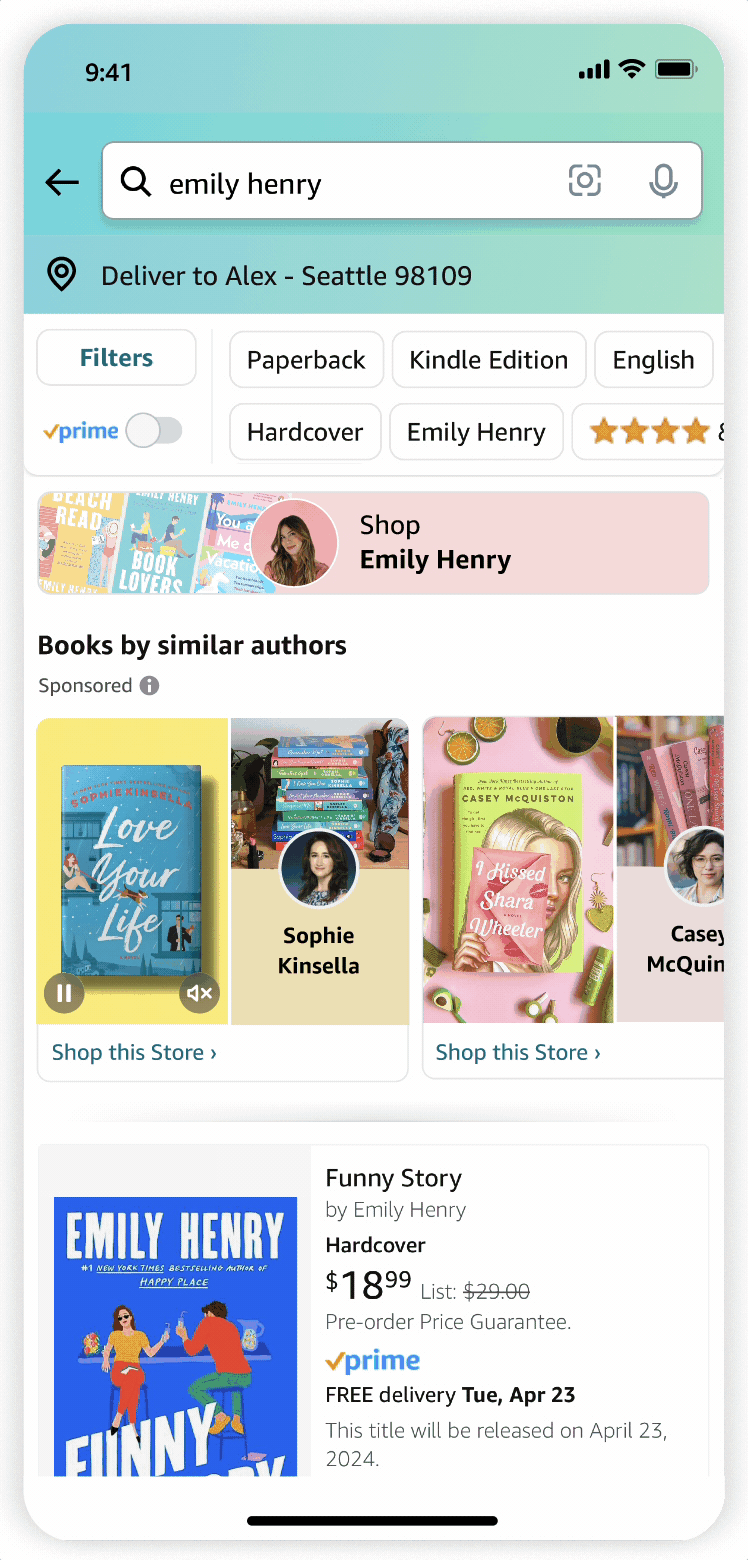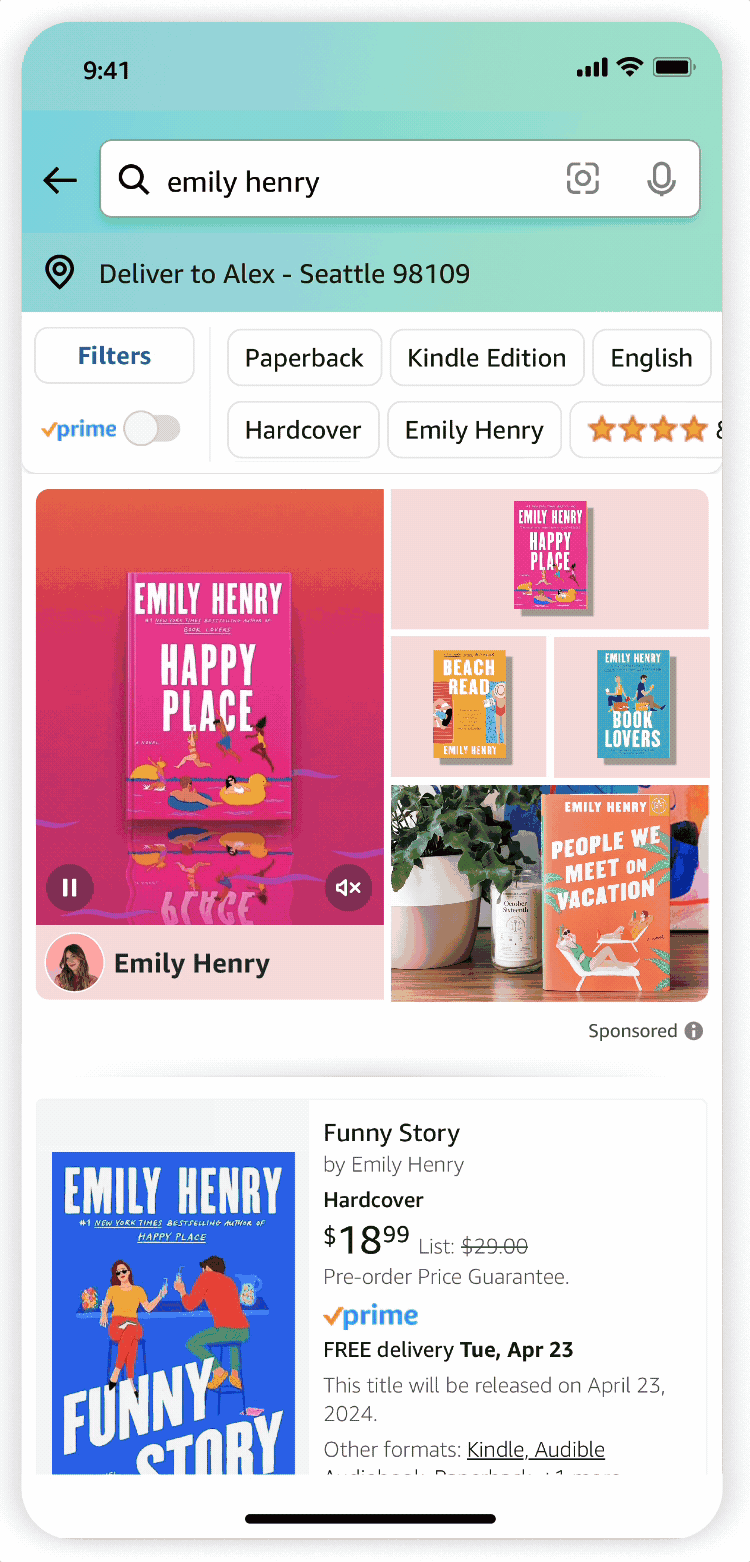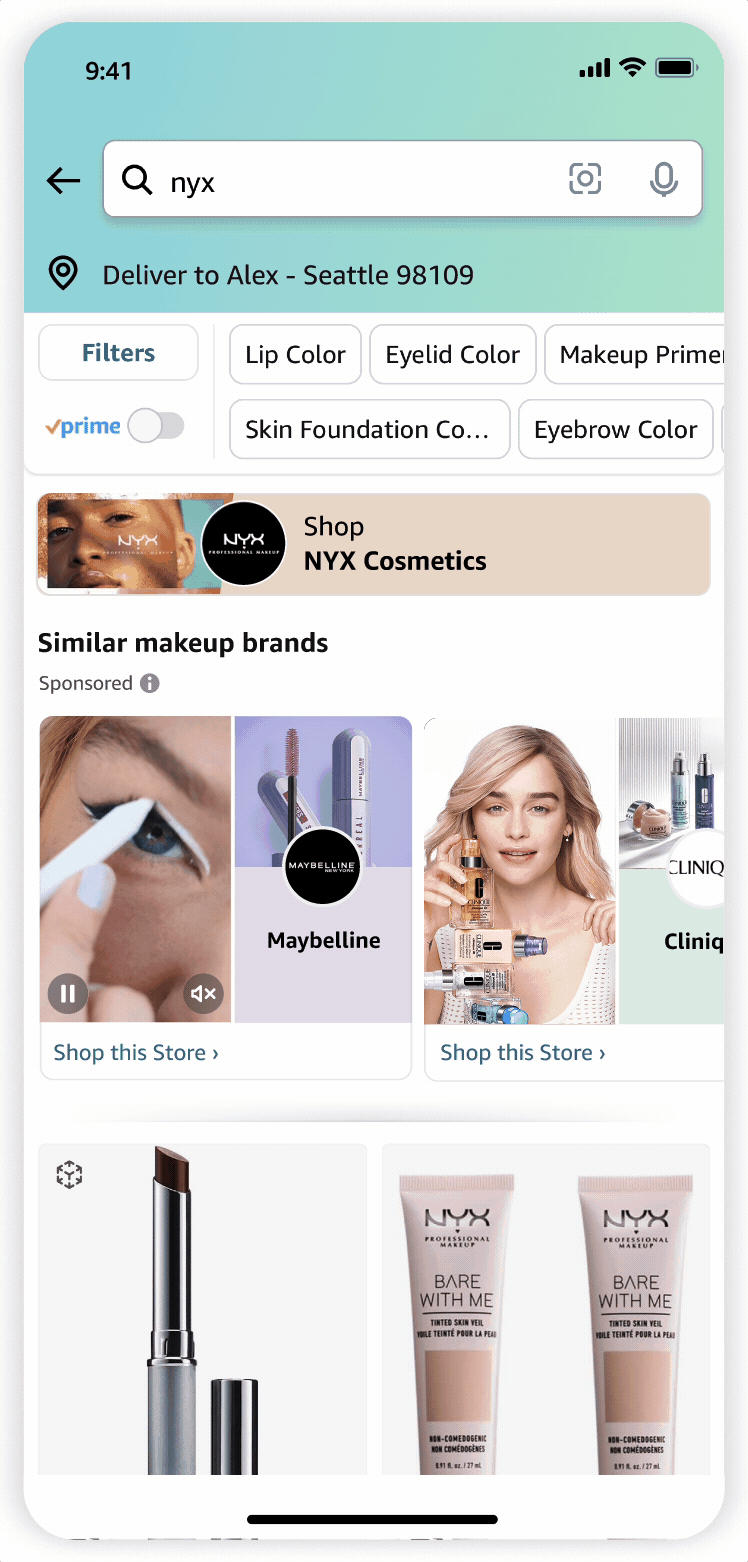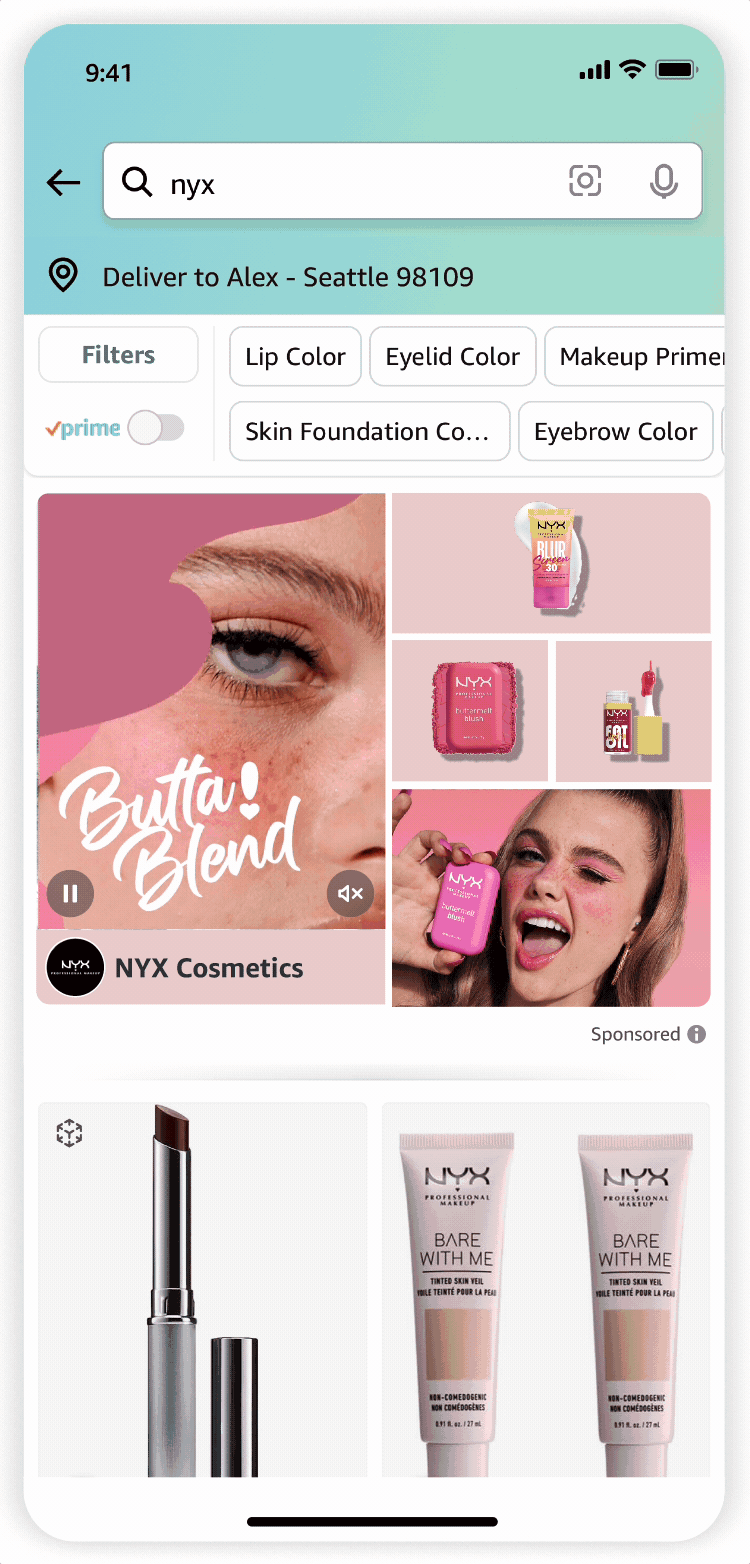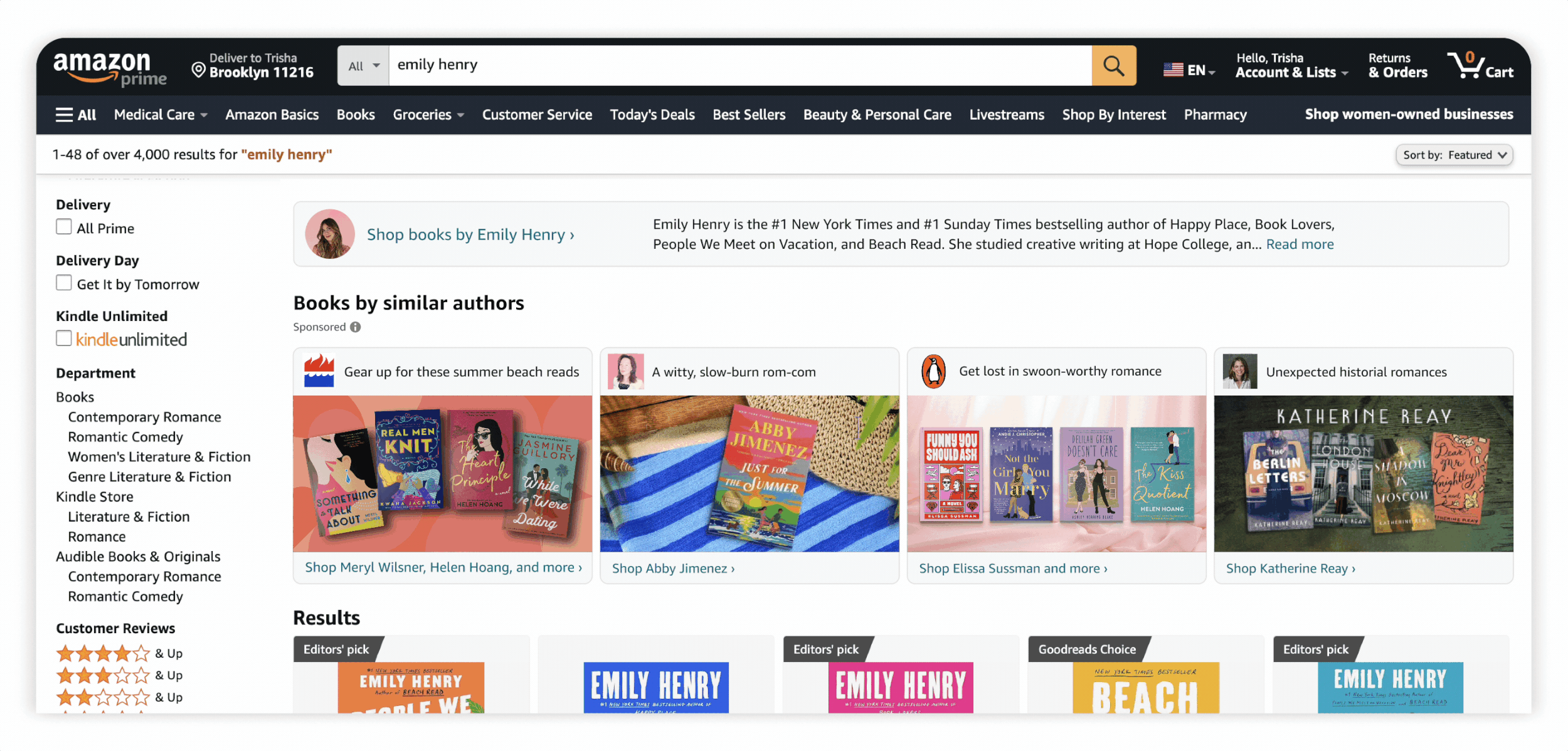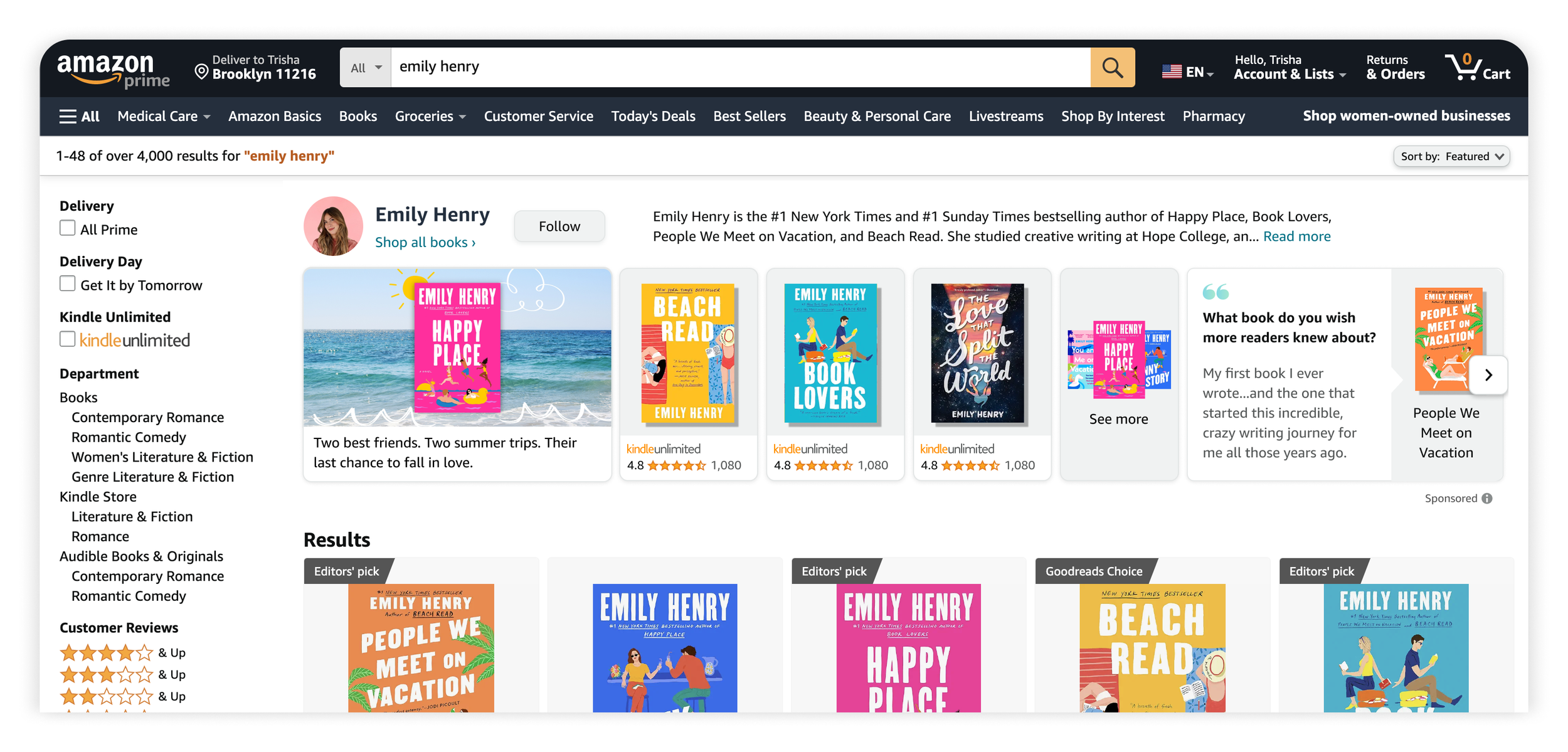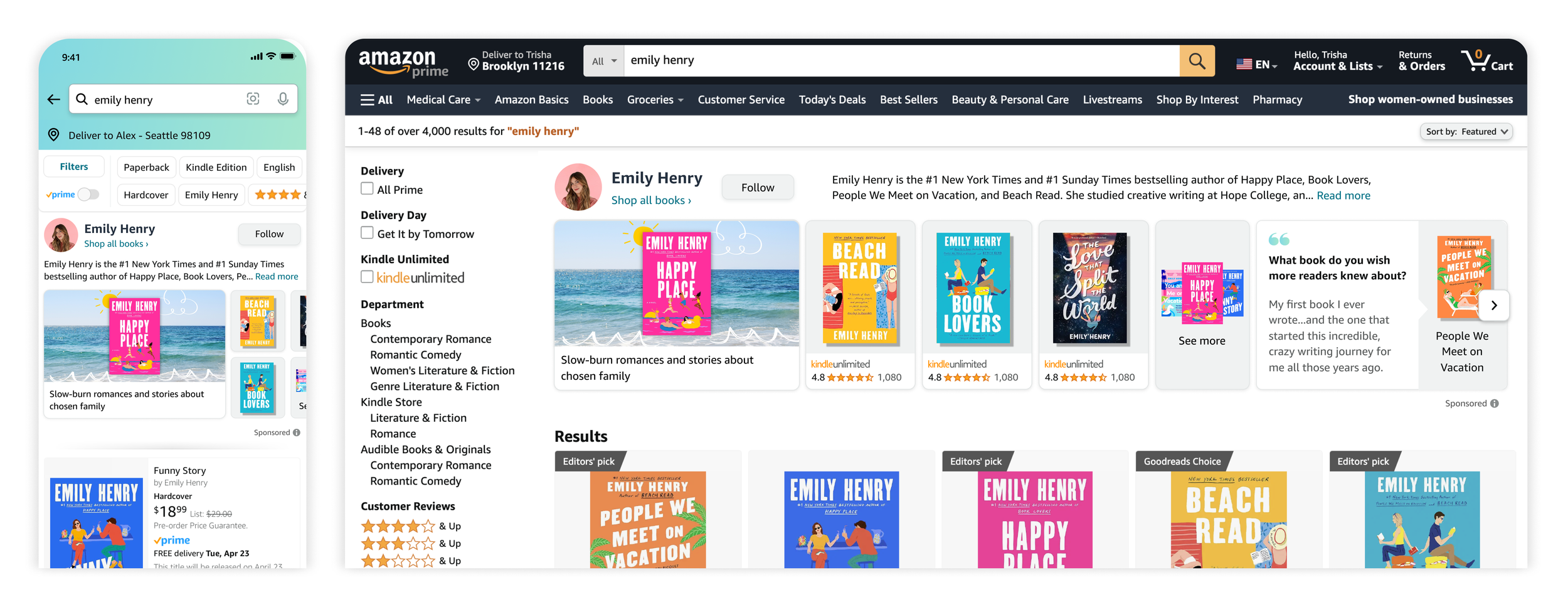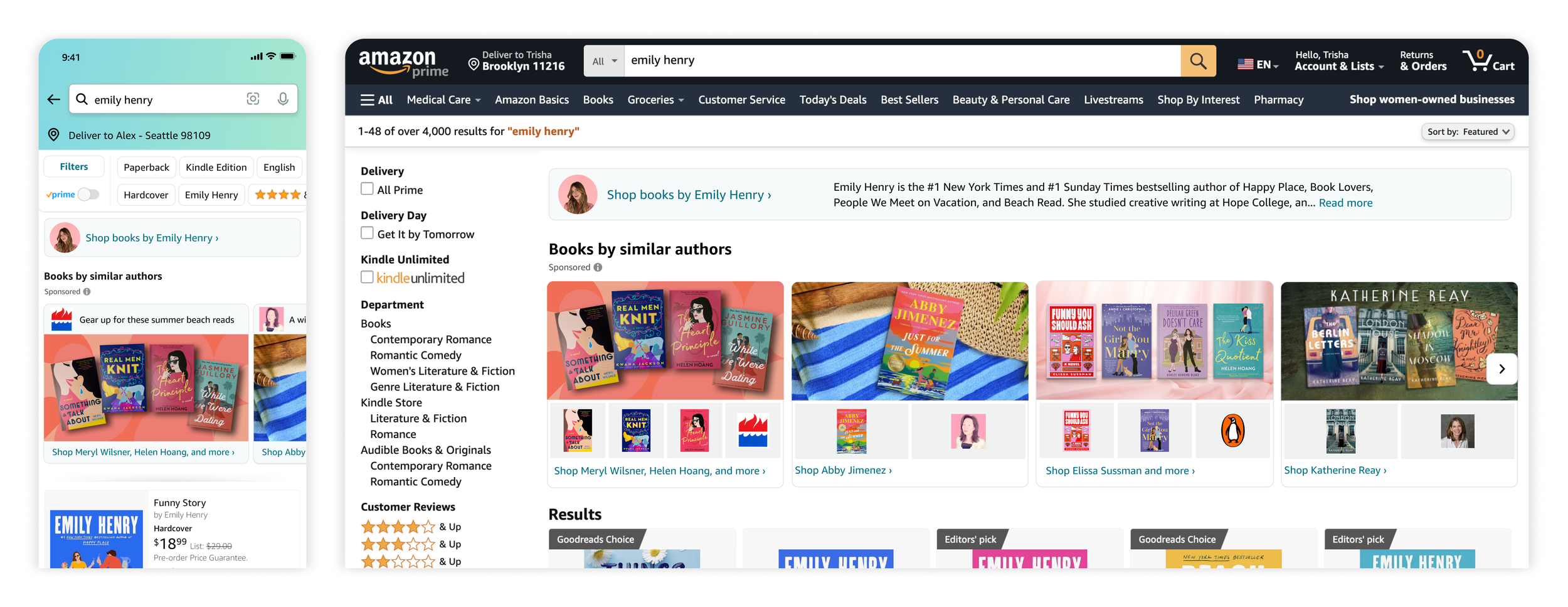AMAZON
Books Top-of-Search
BACKGROUNDIn response to shopper frustrations, advertiser needs, and untapped monetization opportunity, this project reimagined the books top-of-search experience and ads approach, with a focus on author searches. Authors can showcase their brand and maximize search visibility. Shoppers can easily connect with authors and their books in-the-moment, and discover similar authors when there’s competing ads demand.
OUTCOMESThis resulted in a monetization strategy and top-of-search experience with cross-category extensibility to any branded search — spinning the ads flywheel and meeting shopper, advertiser, and business needs. The first experiment milestone drove an increase in CTR (1.3% to 3.3%) and 4% lift in attributed purchases compared to the previous experience.
Influencing and collaborating across several partner teams, this work informed the development of a holistic, component-based creative framework that adapts to customer signals and outputs personalized ad formats shown at key moments in the shopping journey.
ROLEPlayed a key role in developing the strategic framework, and led UX vision and end-to-end process from initial concept to experiment launch.
Framework Development, UX Design, Visual Design
CREDITS
Sai Gantla, Sneh Sharma, Monica Feng
Goals-
Reimagine the books top-of-search experience for author queries to work better for shoppers and advertisers
-
Spin the ads flywheel by driving new advertising demand and better ad performance
-
Create a strategic solution that can scale beyond books, to all categories and any branded search
Vision + framework
From books to cross-category extensibility
The framework responds to different advertiser demand scenarios. When searching for an author, a pixel-frugal organic ingress to the author’s Store and sponsored recommendations for similar authors when there’s non-exact match ads; and a large, premium ‘marquee’ ad when there’s an exact author match ad.
The solution we created was intentionally extensible beyond books for any branded search, and enabled scalability with minimal net-new engineering work. I worked closely with cross-team UX partners on this cross-category extensibility and sequencing of creative experimentation.
An adaptive, dynamic approach
The vision was to transition top-of-search ads from one-size-fits-all to a more adaptive approach with dynamic layouts, pixel footprints, and content focus (brand-forward vs. product-forward).
Responding to customer intents
These ad creatives were envisioned to be flexible across various advertiser objectives (e.g. drive visits to product pages) and shopper outcomes (e.g. when we have shopper signal for product-focused intent).
Evolving a holistic creative formats framework
The original author framework aimed to fulfill shopper and advertiser intents, while aligning to our mental model to be frugal with organic top-slot pixels and aligning to our right-answer-always-first tenet.
This work informed the development of a holistic, component-based creative framework that adapts to customer signals and outputs personalized ad formats shown at key moments in the shopping journey.
Brand marquee ads, for example, adapt content based on the shopper’s search term and their previous relationship with the brand. The framework considers various signals like their browsing and purchase history and content attributes that help build customer trust.
Dynamically responding to personalized signals
An evolution of the brand marquee ad where the content adapts based on the shopper’s search term and their previous relationship or propensity with the brand.
Across the shopper journey
The evolution of a brand’s ads across the different stages of the shopping journey. Highly-personalized and adaptive ad content enhance a shopper’s discovery of relevant brands and products in-the-moment.
Spinning the ads flywheel
The framework and ads strategy we developed hits key needs:
Shopper: Fulfills direct and indirect spearfishing needs known from customer research.
Advertiser: Incentivizes advertiser spend on brand defense to access premium ads, and incentivizes competitor spend to connect with high-intent shoppers.
Business: Drives new advertiser demand and better ad performance with dynamic and personalized approach.
MVP experiments
MOBILENON-EXACT MATCH ADSStore ingress + similar authors
P0 experimentation is in-progress, testing 2 treatments to understand how inclusion of book covers in the ad may impact shopper engagement.
MVP constraints were limited to featuring a static 16:9 brand image. The ad also had to flex to accommodate campaigns from authors (promoting 1 author) as well as book publishers (promoting multiple authors).
EXACT MATCH ADAuthor marquee
Milestone 2 will collect data on performance of the new author marquee ad.
While the MVP was impacted by a re-scoping of product requirements and unanticipated technical challenges with integrating some content, it focused on scalability across most authors — regardless of current content availability.
DESKTOPA peek into the process
REsearch insightsVoice of the customer
author searches, BEFOREShopper pain points
Mismatched ads
Shoppers were often frustrated seeing a large ad for a different author in the top slot. Ads got in the way of the correct answer, introducing friction in these moments.
Limited author info
Shoppers expect more in author discovery and find author content to be informative and inspirational. Ads were product-forward and surface limited author-focused info.
Advertiser pain points
Better brand building
Research showed advertiser brand building needs are unmet, with brand owners indicating Amazon doesn’t do enough to showcase their brands.
Banner blindness
Research showed top-of-search ads are affected by banner blindness, as shoppers have trained themselves to start discovery with the first organic result.
Untapped monetization opportunity
In a small-scale experiment, a large organic author ‘snapshot’ widget was also tested for author searches, but this displaced ads and restricted ad impression opportunities.
Indirect spearfishing opportunity
We also knew from research that when searching for a specific author, shoppers can have the intent to find that particular book (direct spearfishing), but also to use it as a jumping-off point to explore similar authors (indirect spearfishing). In a US study, ~56% of shoppers bought a different book title than the one they searched for on Amazon.
Defining a CORE tenetWe fulfill the shopper intent with the first result.
There’s high sensitivity and risks to shopper perception when irrelevant, top-slot ads get in the way of the correct answer. We established a shared tenet with partner teams to present the right answer before surfacing non-exact match organic or sponsored results.
Defining the framework
EARLY EXPLORATIONSFulfilling shopper and advertiser intents
In early stages, I visualized the beginning seeds of what the new top-of-search framework could look like. This explored how the intended CX mapped to different shopper inputs (narrow vs. broad) and advertiser goals (awareness/discovery vs. purchase), defining nuances of organic and paid content slots, and how to balance the information hierarchy.
Author + title extensibilityDefining marquee content
It was key in early stages to define how a new multi-card brand marquee ad would: 1) show authoritative information, and 2) aggregate and prioritize content. The MVP slots would display a mix of author-curated and auto-generated content from multiple sources.
Thinking holistically, we aimed for the same underlying framework to be extensible to both author and title queries.
EARLY CONCEPTS TO MVPMarquee iterations: Maximizing scalability
Early directions proposed a heavily branded author ‘takeover’ concept. As we refined to a more achievable MVP scoped to author searches, I simplified and systemized, focusing on already-existing content.
I evolved the MVP to include a dynamic packaging of books in the campaign, an author book recommendation, and a new auto-gen card for any author.
EARLY CONCEPTS TO MVPAuthor Store ingress: Balancing pixel frugality
While initial directions were more ‘fully featured’, we hypothesized they would still result in lack of advertiser incentive to bid on ‘marquee’ ad creatives. Simplifying and minimizing to core elements fulfilled exact-match discovery needs while maintaining pixel frugality of this free slot.
The final direction started MVP tests with a simple treatment, and ramps to test ‘bolder’ versions in the future. ‘Follow’ was reserved for the paid marquee ad offering.
INITIAL CONCEPTS TO MVPSimilar authors: Auto-generation to brand
Initial directions had custom image backgrounds and top genre shown for each author. Both were scoped out, and I focused on what could be auto-generated.
At this point, a custom brand image was now required in all campaigns, so I re-focused the MVP to respect that required asset from advertisers as the core branding element.
Initial testing
Initial experiments are testing a lean MVP. To align with our tenet of exact-match answer first, similar authors would always display paired with the organic Author Store ingress even in cases with competing ads demand. When there is an exact match ad from the searched author, the MVP marquee would display.
Impact
The first experiment milestone, testing the non-exact match ad scenario with the new organic ingress and similar author ads, drove lifts in both CTR and attributed purchases — positive signals for the new framework and for future testing. Compared to the previous experience, we saw:
Increase in CTR (3.4% up from 1.3%)
4% lift in attributed purchases
6% lift in annualized ads revenue

